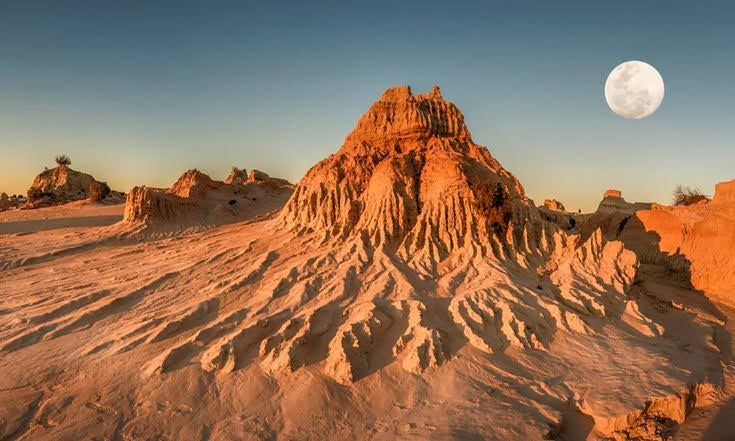
Living Desert Sculpture Symposium: Where Art Meets the Outback in Broken Hill
Explore the Living Desert Sculpture Symposium in Broken Hill, where artistic stone creations meet rugged outback terrain. This 4km loop offers a practical hike paired with striking sculptures that challenge and complement the harsh landscape, appealing to outdoor enthusiasts and art fans alike.
Hydrate Thoroughly
The arid climate demands carrying at least 2 liters of water per person, especially during warmer months. Hydration stops along the trail are nonexistent.
Footwear Matters
Wear sturdy, closed-toe hiking boots with grip to manage loose gravel and uneven surfaces typical of semi-arid trails.
Start Early or Late
Plan your visit around early morning or late afternoon to avoid peak heat and capture the best natural light for photography.
Respect the Environment
Stick to the marked trail to protect fragile vegetation and avoid disturbing local wildlife habitats.
Living Desert Sculpture Symposium: Where Art Meets the Outback in Broken Hill
The Living Desert Sculpture Symposium in Broken Hill, New South Wales, invites adventurers and art lovers alike to explore an outdoor gallery set against the fierce, uncompromising Australian outback. This unique experience combines a modest trek through semi-arid landscapes and native scrub with striking large-scale sculptures crafted from local stone and materials. It’s less about conquering the terrain and more about moving alongside it, discovering how nature and human creativity interact under an expansive sky.
Starting at The Living Desert Reserve, visitors follow a 4-kilometer loop trail that gently rises around 150 meters in elevation. The path is well-defined, featuring packed earth and occasional loose gravel. It requires steady footing but no specialized climbing skill, making it accessible for most fitness levels. The walk prizes patience and attention: as the wind teases the sparse foliage and the sun carves shifting shadows, the sculptures emerge almost organically, their textures echoing the harsh environment.
The sculptures themselves are an invitation — some appear as mythical creatures poised by rugged hillocks, others as abstract forms daring the desert to define them anew. These stone giants are not just static displays; they interact with the glare of daylight and the cool hues of dusk, pushing visitors to reconsider the landscape’s role beyond wilderness.
For anyone considering this adventure, timing matters. Early mornings or late afternoons offer softer light for photography and cooler temperatures for walking. Bring sturdy boots with good tread to handle the variable surface, and pack sufficient water—up to two liters per person is wise given the arid conditions. Seasonal shifts alter the feel dramatically: spring brings wildflowers that momentarily soften the terrain’s austerity, while the heat of summer demands early starts to avoid the midday blaze.
The visit is more than a hike or art tour; it’s an interplay with an environment that resists taming but rewards respect. Whether you pause to examine the intricate chisel marks on a sculpture or simply sit absorbing the panoramic views across Broken Hill’s red earth, the Living Desert Symposium offers a grounded yet inspiring outdoor encounter. Its blend of physical pathfinding and imaginative exploration encapsulates what outdoor art can be: approachable, engaging, and inextricably linked to place.
Nearby Trips
All Adventures
Boat Charters
Water Activities
Adventures near Broken Hill, New South Wales
Discover the unique and memorable adventures that make Broken Hill, New South Wales special.
Frequently Asked Questions
What is the length and terrain type of the Living Desert Sculpture trail?
The trail is approximately 4 kilometers long, forming a loop with a gentle elevation gain of about 150 meters. It primarily consists of packed earth with some gravel stretches, suited for moderate hiking footwear.
Are the sculptures permanently on display and are they accessible year-round?
Yes, the stone sculptures are permanent installations and can be visited any time of year. However, visiting in spring or fall is recommended to avoid extreme weather conditions.
What wildlife might I encounter on the trail?
Commonly seen animals include various reptiles such as bearded dragons and thorny devils, as well as birds like wedge-tailed eagles and Australian magpies. Early or late hikes increase chances of spotting wildlife.
Is the trail kid-friendly or suitable for casual walkers?
The trail is moderately easy and suitable for most casual walkers and families with children used to walking. However, young children should be supervised due to uneven footing and the open environment.
Are there any cultural or historical aspects connected to the sculptures?
The sculptures reflect local Indigenous and outback heritage themes, created by artists during symposiums emphasizing the relationship between land, art, and Australian identity.
What environmental measures are in place to protect this area?
Visitors are encouraged to remain on marked paths to protect fragile vegetation and erosion-prone soils. The reserve is managed with a focus on preserving local flora and fauna ecosystems.
Recommended Gear
Hiking Boots
Provides ankle support and grip necessary for the uneven, gravelly outback terrain.
Water Bottle (2 liters minimum)
Essential for hydration due to the dry, hot environment with no water points on the loop.
Wide-Brim Hat
Protects from harsh sun exposure and helps keep you cool during daylight hours.
Light Jacket or Windbreaker
Useful in cooler months when the desert wind bites, especially at dawn or dusk.
Local Insights
Hidden Gems
- "The "Willy Willy" lookout nearby offers expansive views not often visited by tourists."
- "An ancient sandstone formation just off the main path features subtle Aboriginal engravings."
Wildlife
- "Watch for the elusive mulgara and the colorful painted dragon lizard that thrives in this terrain."
History
"The site is part of traditional lands of the Wiljakali people, with recent art installations highlighting connections between contemporary culture and Indigenous heritage."
